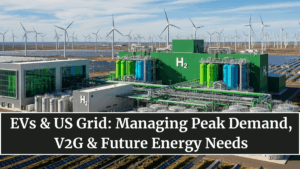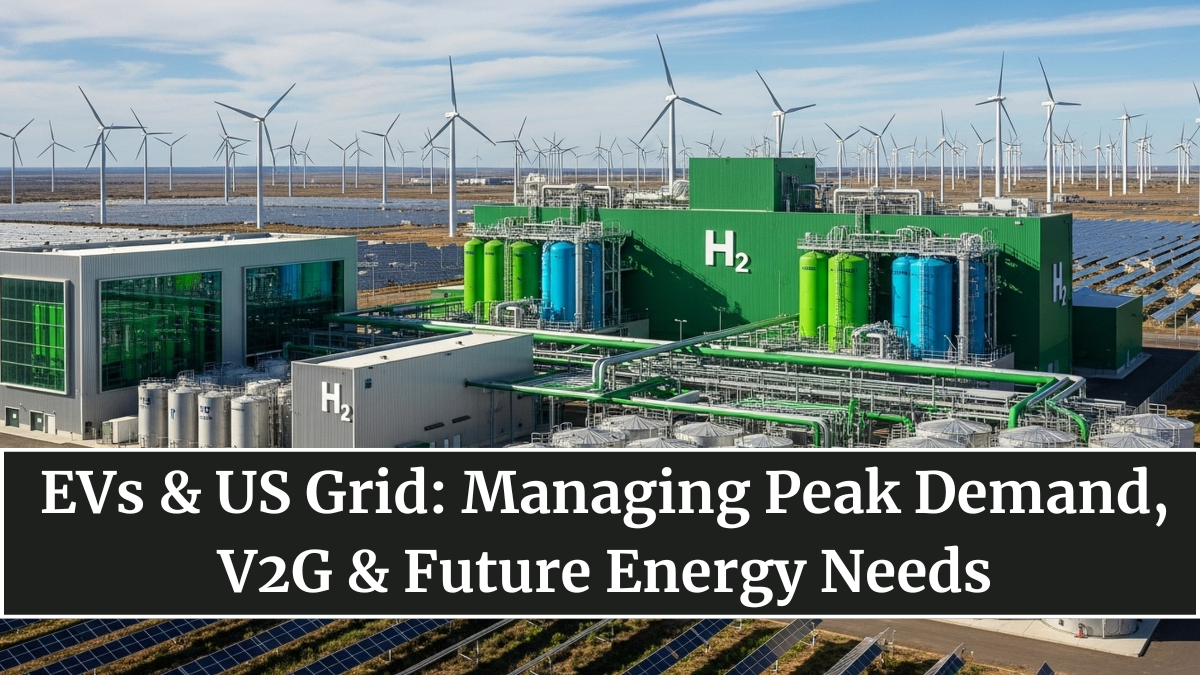America’s electric grid is evolving faster than ever, thanks to the rapid rise of electric vehicles (EVs). What began as a niche market has now become a national priority — one that’s forcing utilities, policymakers, and tech innovators to rethink how power is generated, stored, and distributed.
As EV ownership surges past 15 million vehicles by 2025, the U.S. faces a new challenge: managing peak electricity demand and building smarter, more flexible grids that can sustain the country’s clean energy ambitions.

How EVs Are Reshaping America’s Power Grid
Every new EV plugged in adds pressure to the grid — but also potential. The U.S. energy infrastructure, built decades ago, wasn’t designed for millions of mobile batteries drawing and returning power simultaneously.
Key changes are already visible:
-
Peak load shifts: Evening charging spikes cause new demand surges between 6 PM–10 PM.
-
Regional variation: States like California and Texas are already facing EV-driven load balancing challenges.
-
Increased renewable integration: Solar and wind energy feed directly into smart grids powering EV chargers.
-
Data-driven utilities: Real-time grid monitoring allows predictive load balancing and demand forecasting.
In short, the grid is transforming from a one-way power network into a dynamic, bi-directional energy ecosystem.
The Role of Vehicle-to-Grid (V2G) Technology
One of the most revolutionary innovations in this space is Vehicle-to-Grid (V2G) integration — allowing EVs to return electricity to the grid during peak hours.
Here’s how it works:
-
When plugged in, a V2G-enabled EV communicates with the grid.
-
During high-demand hours, the vehicle discharges stored energy back to the system.
-
When demand drops, the vehicle recharges at lower rates.
This process helps flatten demand peaks and stabilize local grids.
Benefits of V2G include:
-
Grid stability: Prevents overloads during energy demand surges.
-
Lower electricity costs: EV owners earn credits for supplying energy back.
-
Cleaner energy use: Enhances renewable energy reliability during fluctuating supply.
-
Emergency backup: Vehicles act as mobile power sources during outages or disasters.
Utilities in states like California, New York, and Virginia are piloting V2G programs, turning electric cars into energy assets rather than passive consumers.
Challenges of Managing EV-Induced Peak Demand
While the potential is huge, scaling EV-grid integration comes with significant challenges:
-
Aging infrastructure: Many U.S. distribution systems need upgrades for high-load tolerance.
-
Uncontrolled charging: Random, simultaneous charging creates demand spikes.
-
Limited V2G hardware adoption: Only a fraction of current EVs support bidirectional charging.
-
Utility coordination: Regional grids operate under different market and regulatory frameworks.
-
Data security risks: Smart grid systems are vulnerable to cyberattacks and unauthorized access.
Experts estimate that without smart charging coordination, EV-related demand could add 20–25% load pressure on peak-hour grids by 2030.
Smart Solutions Powering the Grid of the Future
The U.S. government, in partnership with major automakers and energy companies, is deploying several advanced solutions:
-
Smart Charging Networks: Intelligent charging systems automatically schedule EV charging during off-peak hours.
-
Dynamic Pricing Models: Time-of-use tariffs incentivize consumers to charge vehicles when grid demand is lowest.
-
Battery Storage Integration: Grid-scale batteries store excess renewable energy for later use.
-
AI Grid Management: Predictive analytics forecast local surges and optimize charging distribution.
-
Public Charging Optimization: EV hubs in cities and highways integrate real-time grid communication to prevent overloads.
Initiatives under the U.S. Department of Energy’s Grid Modernization Plan are ensuring every state moves toward resilience, sustainability, and energy independence.
Economic and Environmental Impact
Beyond electricity management, EV integration supports broader economic and environmental goals:
-
Reduced fossil fuel dependence: Cleaner power sources replace gasoline infrastructure.
-
Job creation: Grid modernization and charging station expansion generate thousands of new technical roles.
-
Emission control: EVs and renewable energy integration lower carbon output by millions of tons annually.
-
Rural electrification: Expanding EV networks bring grid upgrades to underserved areas.
With the right mix of policy, innovation, and investment, the grid will evolve from a strain-prone system into a flexible, self-healing energy network capable of powering both homes and highways.
The Road to 2030: Resilient, Renewable, and Smart
By 2030, U.S. energy planners envision a nationwide V2G-enabled smart grid, capable of managing billions of connected devices — from cars and trucks to homes and solar farms.
Future trends shaping this evolution include:
-
Universal V2G compatibility in all major EV models.
-
AI-driven charging infrastructure predicting and balancing energy loads.
-
Integration of renewables with distributed energy storage.
-
Grid-to-home power sharing, where EVs act as household batteries.
The synergy between mobility and energy will define America’s next industrial revolution — one powered not by oil, but by intelligent electrons and connected vehicles.
FAQs
How does vehicle-to-grid (V2G) technology help the power grid?
V2G allows EVs to supply power back to the grid during peak demand, helping stabilize voltage and reduce blackouts.
Which states are leading in EV grid integration?
California, New York, and Texas are at the forefront, with multiple V2G pilot projects and smart grid initiatives underway.
Can EVs really power homes or the grid?
Yes. With bidirectional charging, EVs can power homes during outages or return energy to the grid when needed.
Will mass EV adoption strain the U.S. grid?
If unmanaged, yes — but with smart charging, dynamic pricing, and storage technology, grids can handle future demand efficiently.
What’s the long-term vision for EV-grid synergy?
By 2030, the U.S. aims for a fully connected, renewable-powered smart grid where EVs double as mobile energy assets.
Click here to know more.
